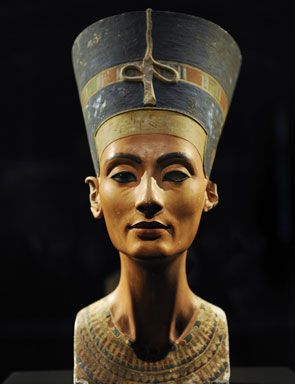"The Triumph of the Apollonian Image"
 Nefertiti Bust, 14th Century B.C.
Nefertiti Bust, 14th Century B.C.
Camille Paglia defines the world into two contrasting elements:
- The Apollonian (from the Greek sky god Apollo) who personifies culture, order and Art.
- The Dionysian (from Dionysus, the god of wine, agriculture, and fertility of nature) who identifies with the mysterious, the irrational, the impulsive and especially the uncontrollable Nature.
- The Apollonian tries to bring order to the natural through art and rationality.
Camille Paglia describes the Apollonian as "The form-making aspect of the mind." and, "...all art is Apollonian."
Below are quotes from "The Birth of the Western Eye," the second chapter of Camille Paglia's Sexual Personae: Art and Decadence from Nefertiti to Emily Dickenson:
- [Nefertiti] is the triumph of Apollonian image over the humpiness and horror of mother earth. Everything fat, slack, and sleepy is gone. The western eye is open and alert. It has forced objects into their frozen frame…Taut, still, and truncated, Nefertiti is...[w]estern culture, moving up toward Apollonian sunlight…
- She is [the] icy line of Apollonian identity.
Nefertiti is subtraction. Visually, she has been reduced to her essence...She is abbreviation, a symbol or pictogram...
- [T]he idea of beauty is based on enormous exclusions. So much is excluded from the Nefertiti bust that we can feel its silhouette straining against the charged atmosphere, a combat of Apollonian line.
- Nefertiti [is] Apollonian head-magic. Thinking makes it so.
- Nefertiti is like Athena born from the brow of Zeus, a head-heavy armoured goddess.
- With her welcoming but uncanny smile, Nefertiti is western personality in its ritual bonds. Exquisite and artificial, she is mind-made image forever caught in radiant Apollonian freezeframe.













